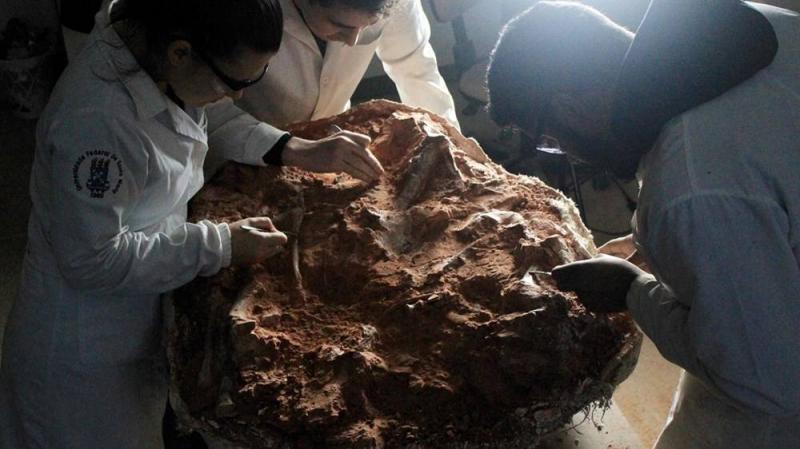Heavy rains, which caused historic floods in southern Brazil, revealed a dinosaur fossil dating back approximately 200 million years, in "very good condition of preservation," according to the team of scientists who discovered it. This fossil was identified last May in the region of "São João do Polesine," about 300 kilometers from "Porto Alegre," in one of the lowlands of the "Pampa," which is rich in treasures that intrigue fossil enthusiasts in Brazil.
The fossil dates back to the Triassic period, which spans from 250 to 200 million years ago, before the Jurassic period, known globally thanks to the famous Hollywood film "Jurassic Park."
After four days of excavation, a team of paleontologists from the Federal University of Santa Maria (UFSM) managed to remove and transport the rock mass containing the fossilized skeleton to its research center. According to the initial observations from this renowned center, the fossil belongs to a member of the Herrerasauridae family, which were long-tailed, carnivorous animals that walked on two legs and inhabited areas currently located in Argentina and Brazil.
Rodrigo Tim Muller, who is responsible for the excavation operations, states, "Not only is it among the oldest dinosaur fossils in the world, but it is also in very good condition of preservation and will provide us with a lot of information about the anatomy of these dinosaurs." Muller notes that this discovery might be the second most complete fossil known so far in the Herrerasauridae family. The same area witnessed the discovery of an earlier fossil in 2014, leading to the identification of a new species with curved claws named Gnathovorax cabreirai.
Extensive analyses will be needed for scientists to determine whether the fossil extracted from the rock in May belongs to the same species or not. Rodrigo Tim Muller emphasizes that this work is "very delicate, almost surgical," and may take "several months." He stresses that "the smallest part can contain information that we cannot obtain if it gets damaged."
At the end of the work, results are expected to be published in a scientific journal.
The "Pampa" plains in southern Brazil, near the borders with Argentina and Uruguay, hide around a hundred rich fossil-bearing deposits beneath their red soil that reveal treasures from the age of early dinosaurs. The heavy rains and floods that struck the area last May resulted in the deaths of over 180 people and caused immense material damage.
Regarding paleontological research, these exceptional deposits have played a partially beneficial role by "accelerating erosion," thus revealing the Herrerasauridae fossil, which would not have been discovered for a long time under normal circumstances, according to Rodrigo Tim Muller. However, they also have downsides, as the heavy rains "destroy a lot of material" in the fossils, especially small shards.
For this reason, paleontologists closely monitor the deposits, looking for exposed parts in the open air and intensifying their efforts during excavations to recover the fossils in the best possible condition.




